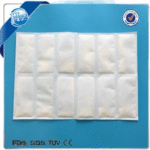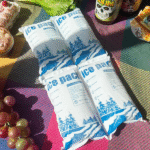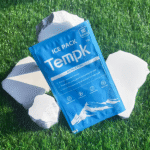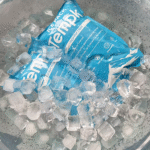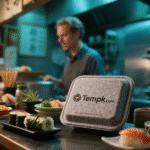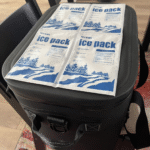Unterschied zwischen Trockeneis und Eisbeutel: Welche für Ihre Sendung auswählen zu wählen?
Beim Versandtemperaturempfindlichkeitsprodukte, the choice between dry ice and ice packs can significantly impact your cold chain efficiency. Each has its unique benefits, but which one should you use for your specific needs? This guide will break down the differences between dry ice and ice packs, helping you determine the best option for your shipments.
-
How dry ice and ice packs work to maintain temperature
-
Key differences in their cooling properties
-
Best use cases for dry ice vs ice packs
-
Cost and environmental considerations
-
Safety tips when using dry ice and ice packs in shipments
How Do Dry Ice and Ice Packs Differ in Cooling?
Dry ice is solid CO₂ that sublimates at –78.5°C, providing ultra‑cold temperatures perfect for keeping products frozen during long shipments. Eisbeutel, auf der anderen Seite, contain a phase-change material (PCM) that stays cool within the 0–8°C range, making them suitable for refrigerated items but not for frozen goods.
Trockeneis ist ideal für long-duration shipments that require freezing, while ice packs are better for short-term cooling when refrigeration is needed.
Key Differences Between Dry Ice and Ice Packs
| Kühlmethode | Temperaturbereich | Ideale Verwendung | Kühldauer |
|---|---|---|---|
| Trockeneis | –78,5 ° C. | Gefrorenes Essen, Arzneimittel | 24–72 Stunden |
| Eisbeutel | 0–8 ° C | Kühlgüter, medizinische Versorgung | 12–48 Stunden |
Practical Tips
-
Use dry ice for frozen goods: Best for items that need to remain frozen for extended periods.
-
Use ice packs for refrigerated items: Perfect for maintaining the 2–8°C range for medical or food items for up to two days.
-
Für Sendungen mit mehreren Temperaturen: Consider using both—dry ice for frozen products and ice packs for refrigerated goods.
Beispiel für Real -Life: A logistics company successfully shipped a variety of frozen and refrigerated goods by using dry ice for frozen products and ice packs for fresh produce, keeping all items at the correct temperatures for 72 Std..
When Should You Use Dry Ice Over Ice Packs?
Dry ice is the best option when you need sub-zero temperatures, typically for long-duration shipments or for products like gefrorenes Essen, Arzneimittel, oder biologische Proben. The extreme cold of dry ice keeps items frozen during transport, especially in situations where refrigeration won’t suffice.
Jedoch, dry ice has a few downsides—it sublimates quickly, and it requires special ventilation due to the carbon dioxide it releases, making it unsuitable for certain environments or smaller shipments.
Beste Verwendung für Trockeneis
-
Tiefkühlkost: Ideal for ice cream, gefrorenes Fleisch, or seafood that needs to remain frozen during long shipments.
-
Pharmazeutika: Used for medications like vaccines or biologics that need to stay frozen throughout transit.
-
Extended Shipping: Dry ice is essential for shipments that will take more than 24 Std., ensuring temperature control for multiple days.
Dry Ice vs Ice Packs for Frozen Products
| Produkttyp | Effektivität von Trockeneis | Ice Packs Effectiveness | Beste Verwendung |
|---|---|---|---|
| Gefrorene Lebensmittel | Hochwirksam | Unwirksam | Dry ice for long trips |
| Pharmazeutika | Hochwirksam | Unwirksam | Dry ice for frozen meds |
| Biologika | Hochwirksam | Unwirksam | Dry ice for critical shipments |
When Should You Use Ice Packs Over Dry Ice?
Ice packs are perfect for maintaining refrigerated temperatures, Typischerweise zwischen 0–8 ° C.. They are ideal for shipments that do not need freezing but require a stable cool environment. Ice packs are commonly used for short-term transport Und easy-to-handle applications.
Ice packs are easier to use than dry ice—no special ventilation is required, and they are typically more kostengünstig for smaller shipments.
Best Uses for Ice Packs
-
Medizinische Versorgung: Keep items like insulin, Impfungen, or antibiotics cool during transit.
-
Frisches Essen: Use for products like fruits, Gemüse, Molkerei, or meats that need refrigeration but not freezing.
-
Shorter Shipping Durations: Ideal for shipments under 48 hours that don’t need freezing temperatures.
Ice Packs vs Dry Ice for Refrigerated Products
| Versandtyp | Ice Packs Effectiveness | Effektivität von Trockeneis | Beste Verwendung |
|---|---|---|---|
| Refrigerated Goods | Hochwirksam | Unwirksam | Ice packs for short trips |
| Pharmazeutika | Hochwirksam | Unwirksam | Ice packs for refrigerated meds |
| Kosmetika | Hochwirksam | Unwirksam | Ice packs for temperature-sensitive items |
Kosten- und Umweltüberlegungen: Trockeneis gegen Eisbeutel
Dry ice can be more expensive because it must be replenished frequently during long shipments. Zusätzlich, it is a sublimating material, meaning that it releases carbon dioxide as it evaporates, Beitrag zu Treibhausgasemissionen. Proper handling and disposal are crucial for safety and sustainability.
Eisbeutel, auf der anderen Seite, Sind wiederverwendbar, making them a more umweltfreundlich Und kostengünstig solution for many shipments. They don’t produce gases and can be disposed of with minimal impact on the environment.
Kostenvergleich: Trockeneis gegen Eisbeutel
| Kühlmethode | Durchschnittskosten pro Sendung | Umweltauswirkungen | Beste Verwendung |
|---|---|---|---|
| Trockeneis | $25- $ 50 | Hoch (Co₂ -Emissionen) | Langfristige gefrorene Waren |
| Eisbeutel | $10- $ 30 | Niedrig (ungiftig, wiederverwendbar) | Kurzfristige Kühlgüter |
2025 Trends in der Kaltkette -Logistik: Innovationen und Vorschriften
Der Kaltkette Logistikindustrie entwickelt sich mit mehr weiter eco-friendly cooling options, as sustainability becomes a top priority. Gelpackungen Und smart temperature monitoring devices are becoming more common, while dry ice technologies are being developed to reduce sublimation rates and carbon emissions.
Neueste Trends
-
Sustainable cooling solutions: More companies are adopting biodegradable ice packs and more efficient dry ice usage.
-
Smart temperature tracking: The integration of IoT-based devices to monitor temperature during transport is improving cold chain efficiency.
-
Regulation updates: Stricter rules around the use of dry ice and gel packs to ensure environmental responsibility.
Markteinsicht: The shift towards green logistics is evident, mit 28% of cold chain companies reporting a move toward sustainable packaging solutions.
Häufig gestellte Fragen {#FAQ}
Q: Can I use dry ice for refrigerated products?
NEIN, dry ice is too cold for refrigerated products that require temperatures above –20°C. Ice packs are better for keeping goods cool but not frozen.
Q: How long do ice packs last compared to dry ice?
Ice packs typically last 12–48 hours, while dry ice can last 24–72 hours depending on the shipment size and insulation.
Q: Ist trockeneis sicher zu handhaben?
Ja, but it must be handled with care, using insulated gloves, and must be properly ventilated to avoid CO₂ build-up.
Zusammenfassung & Imbiss
Dry ice and ice packs are both essential for cold chain logistics, but they serve different purposes. Verwenden dry ice for frozen goods Und ice packs for refrigerated products that require cooling without freezing. In Betracht ziehen kosten, Umweltauswirkungen, und die duration of shipment when deciding which cooling method to use.
What to Do Next
-
Bewerten Sie Ihre Versandanforderungen and choose the right cooling method based on your products.
-
Order dry ice or ice packs von tempk für Ihre nächste Sendung.
-
Share this guide with your logistics team to streamline your cold chain processes.
Über Tempk
Tempk specializes in high-quality temperature-controlled packaging for a variety of industries. Egal, ob Sie Pharmazeutika versenden, Essen, oder andere sensible Produkte, we offer the best cooling solutions to maintain optimal temperatures.
Benötigen Sie Unterstützung bei Ihren kalten Kettenbedürfnissen? Kontaktieren Sie uns for tailored solutions and expert advice.

















